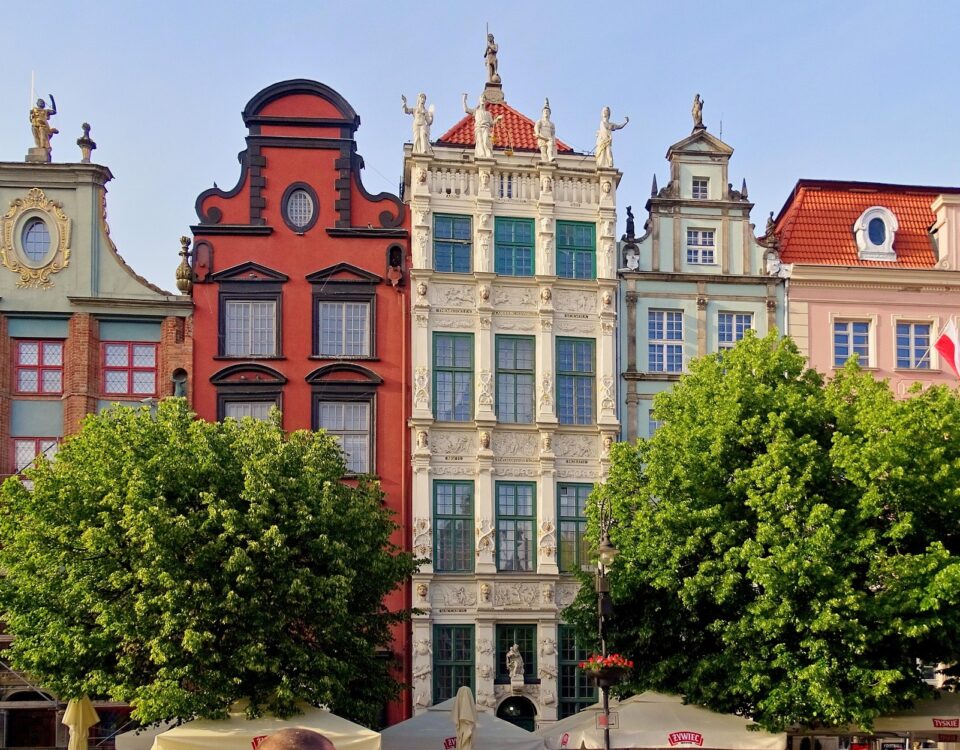
10 Best Cities to Visit in Eastern Europe (You’ll Fall in Love With #7!)
2025-09-01
Eastern European Food Culture:Traditional Flavors and Recipes | Ultimate 2025 Guide
2025-10-12Moving abroad or working remotely is more than just an adventure—it’s about choosing a place where you can balance affordability, quality of life, career opportunities, and culture. Eastern Europe has quickly become one of the top choices for expats and digital nomads, thanks to its low cost of living, fast-growing tech scene, and unique cultural blend.
In this guide by TripToEast, we’ll explore why Eastern Europe is a smart option, dive into the statistics, compare cities, and provide practical tips to help you settle in smoothly. Whether you’re considering a short-term stay or long-term relocation, this guide has you covered.
Why Eastern Europe? The Big Picture of Expats and Digital Nomads
Eastern Europe is no longer the “hidden gem” it once was—it’s now firmly on the map for digital nomads and expats. According to Nomad List (2025), cities like Tallinn, Kraków, and Tbilisi are in the top 20 globally for remote work.
Here’s why:
-
Affordable living: Many cities cost 50–70% less than Western Europe.
-
High internet speed: Romania, Hungary, and Bulgaria consistently rank among the fastest internet providers in the world.
-
Strong expat communities: Places like Budapest, Prague, and Warsaw now host thousands of digital nomads.
-
Cultural richness: Medieval towns, diverse cuisines, and centuries of history are just a train ride away.
-
Proximity to Western Europe: Quick flights make it easy to mix East and West.
👉 If you’re seeking an affordable base without sacrificing lifestyle, Eastern Europe delivers.

Eastern Europe for Expats and Digital Nomads
Cost of Living in Eastern Europe
Let’s compare average monthly living costs for a single expat/digital nomad (USD):
| City | Rent (1BR in center) | Food & Groceries | Coworking Space | Monthly Total |
|---|---|---|---|---|
| Kraków, Poland | $550 | $250 | $120 | $1,200 |
| Budapest, Hungary | $600 | $280 | $110 | $1,250 |
| Sofia, Bulgaria | $450 | $200 | $100 | $1,050 |
| Tbilisi, Georgia | $400 | $180 | $90 | $950 |
| Tallinn, Estonia | $700 | $300 | $140 | $1,400 |
| Bucharest, Romania | $500 | $220 | $100 | $1,050 |
💡 TripToEast Insight: Eastern Europe is ideal if you want European living standards without the Western European price tag. Tbilisi and Sofia, in particular, are among the cheapest nomad-friendly cities in Europe.
Internet Speeds & Connectivity
For digital nomads, internet speed is non-negotiable. Good news—Eastern Europe consistently outperforms many Western countries.
-
Romania: Avg. 260 Mbps
-
Hungary: Avg. 180 Mbps
-
Estonia: Avg. 140 Mbps
-
Georgia: Avg. 75 Mbps (growing quickly)
Remote workers can easily rely on cafes, coworking spaces, and 4G/5G coverage across most urban centers.

Visa & Residency Options
Eastern Europe is known for flexible visas compared to stricter Western countries. Here’s a breakdown:
-
Georgia: One of the easiest countries—visa-free entry for 365 days for over 90 nationalities.
-
Estonia: Pioneered the Digital Nomad Visa (1 year stay, income proof required ~$3,500/month).
-
Czech Republic: Offers a Freelance Visa for self-employed professionals.
-
Hungary: White Card Visa for digital nomads (up to 2 years).
-
Poland & Romania: Easy to apply for temporary residency if you work or study.
👉 If you’re not sure where to begin, Georgia is the best low-barrier entry point, while Estonia is excellent for digital-first workers.

Best Cities in Eastern Europe for Expats & Digital Nomads
Let’s break down the top cities you should consider, based on affordability, expat community, safety, and lifestyle.
1. Budapest, Hungary
-
Why it’s great: Stunning architecture, thriving café culture, buzzing nightlife.
-
Expat scene: Large international community, tons of coworking spaces.
-
Monthly budget: ~$1,250
-
Tip: Public transport is cheap and efficient—get a monthly pass.
2. Kraków, Poland
-
Why it’s great: Beautiful old town, strong startup ecosystem, student-friendly.
-
Expat scene: Young professionals and tech workers dominate.
-
Monthly budget: ~$1,200
-
Tip: Avoid tourist-heavy restaurants; local bars and milk bars offer meals under $5.
3. Sofia, Bulgaria
-
Why it’s great: Affordable living, mountain views, and a relaxed vibe.
-
Expat scene: Growing digital nomad network, popular with long-term stayers.
-
Monthly budget: ~$1,050
-
Tip: Bulgaria is part of the EU but not in the Schengen zone—perfect for visa runs.
4. Tbilisi, Georgia
-
Why it’s great: One of the most affordable cities in Europe, warm hospitality, and year-long visa-free stay.
-
Expat scene: Fast-growing nomad hub with a friendly local culture.
-
Monthly budget: ~$950
-
Tip: Join local meetups—Georgians are extremely welcoming.
5. Tallinn, Estonia
-
Why it’s great: Digital-first city with e-Residency and efficient government services.
-
Expat scene: International, tech-driven, innovative.
-
Monthly budget: ~$1,400
-
Tip: Great if you want to build a business while traveling.
6. Bucharest, Romania
-
Why it’s great: Fast internet, lively nightlife, affordable food and housing.
-
Expat scene: Large expat communities, especially in tech.
-
Monthly budget: ~$1,050
-
Tip: Explore day trips to Transylvania for a break from city life.

Eastern Europe for Expats and Digital Nomads
Lifestyle & Culture
Living in Eastern Europe isn’t just about work—it’s about the experience.
-
Food: From Polish pierogi and Georgian khachapuri to Bulgarian banitsa, every country has unique, budget-friendly cuisines.
-
Transport: Trains and buses are affordable and connect most major cities. Flixbus and budget airlines like WizzAir make travel cheap.
-
Culture & History: Castles, cathedrals, Soviet history, and vibrant traditions add depth to your stay.
-
Weather: Expect cold winters in the north (Estonia, Poland) and milder winters in the south (Bulgaria, Georgia).

Eastern Europe for Expats and Digital Nomads
Safety & Healthcare
-
Safety: Most Eastern European countries rank safe for expats. For example, Poland ranks 17th in the Global Peace Index.
-
Healthcare: Public systems exist, but private healthcare is affordable compared to Western Europe. Health insurance is recommended for nomads.
Challenges Expats Face
While Eastern Europe is welcoming, you should be aware of:
-
Language barriers: English is widely spoken in major cities, but less so in rural areas.
-
Bureaucracy: Paperwork can be slow in some countries.
-
Cold winters: Not for everyone—some areas dip below -10°C.
-
Payment systems: Some countries are still cash-heavy.
💡 Tip from TripToEast: Learn a few local phrases—it helps with daily life and builds connections quickly.
Eastern Europe vs. Western Europe for Digital Nomads
| Factor | Eastern Europe | Western Europe |
|---|---|---|
| Cost of Living | Low ($950–$1,400) | High ($2,000–$3,500) |
| Internet | Faster in many areas | Good, but expensive |
| Culture | Emerging & authentic | More globalized |
| Visa Options | Easier (e.g., Georgia, Estonia) | Stricter rules |
| Community | Growing rapidly | Established, but costly |
👉 Bottom Line: Eastern Europe offers 70% of the Western Europe experience for less than half the price.
Practical Tips for Moving to Eastern Europe
-
Banking & Payments: Use Wise or Revolut for international transfers. Many countries are cash-preferred, so always carry some.
-
Accommodation: Airbnb, Facebook expat groups, and local rental sites are best for medium to long stays.
-
Coworking: Try Impact Hub (Bucharest), LOKAL (Tbilisi), or Kaptár (Budapest).
-
Healthcare: Private clinics often have English-speaking staff and quick service.
-
Transport: Buy monthly metro passes—they’re cheaper than daily tickets.
-
Community: Join expat groups on Meetup or Facebook for networking.

Eastern Europe for Expats and Digital Nomads
Future of Eastern Europe for Nomads
Eastern Europe is on track to become one of the biggest global hubs for digital nomads:
-
Tech startups are booming in Poland, Estonia, and Romania.
-
Remote work visas are being introduced in more countries.
-
Infrastructure (internet, coworking, transport) continues to improve.
According to Eurostat, the number of foreign residents in Eastern Europe increased by 18% from 2020 to 2024. This trend shows no signs of slowing down.
Final Thoughts
Eastern Europe is no longer just a “cheap alternative” to Western Europe. It’s a dynamic, affordable, and inspiring hub for digital nomads and expats. With welcoming communities, high-speed internet, and an unbeatable cost of living, it’s the perfect place to live, work, and explore.
At TripToEast, our mission is to help you make the transition smoother. Whether you’re moving to Budapest, Kraków, or Tbilisi, we’ve got resources to guide your journey.
👉 Ready to take the leap? Start planning your Eastern Europe adventure with TripToEast.com and discover your new home abroad.





